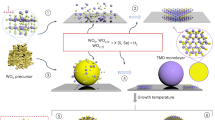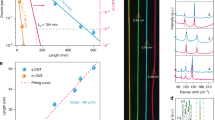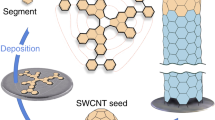Abstract
Carbon nanotubes have many material properties that make them attractive for applications1,2. In the context of nanoelectronics3, interest has focused on single-walled carbon nanotubes4 (SWNTs) because slight changes in tube diameter and wrapping angle, defined by the chirality indices (n, m), will shift their electrical conductivity from one characteristic of a metallic state to one characteristic of a semiconducting state, and will also change the bandgap. However, this structure–function relationship can be fully exploited only with structurally pure SWNTs. Solution-based separation methods5 yield tubes within a narrow structure range, but the ultimate goal of producing just one type of SWNT by controlling its structure during growth has proved to be a considerable challenge over the last two decades6,7,8,9. Such efforts aim to optimize the composition6,10,11,12,13,14,15,16,17 or shape18,19,20,21 of the catalyst particles that are used in the chemical vapour deposition synthesis process to decompose the carbon feedstock and influence SWNT nucleation and growth22,23,24,25. This approach resulted in the highest reported proportion, 55 per cent, of single-chirality SWNTs in an as-grown sample11. Here we show that SWNTs of a single chirality, (12, 6), can be produced directly with an abundance higher than 92 per cent when using tungsten-based bimetallic alloy nanocrystals as catalysts. These, unlike other catalysts used so far, have such high melting points that they maintain their crystalline structure during the chemical vapour deposition process. This feature seems crucial because experiment and simulation both suggest that the highly selective growth of (12, 6) SWNTs is the result of a good structural match between the carbon atom arrangement around the nanotube circumference and the arrangement of the catalytically active atoms in one of the planes of the nanocrystal catalyst. We anticipate that using high-melting-point alloy nanocrystals with optimized structures as catalysts paves the way for total chirality control in SWNT growth and will thus promote the development of SWNT applications.
This is a preview of subscription content, access via your institution
Access options
Subscribe to this journal
Receive 51 print issues and online access
$199.00 per year
only $3.90 per issue
Buy this article
- Purchase on Springer Link
- Instant access to full article PDF
Prices may be subject to local taxes which are calculated during checkout




Similar content being viewed by others
References
Shulaker, M. M. et al. Carbon nanotube computer. Nature 501, 526–530 (2013)
De Volder, M. F. L., Tawfick, S. H., Baughman, R. H. & Hart, A. J. Carbon Nanotubes: present and future commercial applications. Science 339, 535–539 (2013)
Avouris, P., Chen, Z. & Perebeinos, V. Carbon-based electronics. Nature Nanotechnol. 2, 605–615 (2007)
Iijima, S. & Ichihashi, T. Single-shell carbon nanotubes of 1-nm diameter. Nature 363, 603–605 (1993)
Hersam, M. C. Progress towards monodisperse single-walled carbon nanotubes. Nature Nanotechnol. 3, 387–394 (2008)
Bachilo, S. M. et al. Narrow (n,m)-distribution of single-walled carbon nanotubes grown using a solid supported catalyst. J. Am. Chem. Soc. 125, 11186–11187 (2003)
Ding, F., Harutyunyan, A. R. & Yakobson, B. I. Dislocation theory of chirality-controlled nanotube growth. Proc. Natl Acad. Sci. USA 106, 2506–2509 (2009)
Liu, J. et al. Chirality-controlled synthesis of single-wall carbon nanotubes using vapour-phase epitaxy. Nature Commun. 3, 1199 (2012)
Chen, Y. et al. Helicity-dependent single-walled carbon nanotube alignment on graphite for helical angle and handedness recognition. Nature Commun. 4, 2205 (2013)
An, L., Owens, J. M., McNeil, L. E. & Liu, J. Synthesis of nearly uniform single-walled carbon nanotubes using identical metal-containing molecular nanoclusters as catalysts. J. Am. Chem. Soc. 124, 13688–13689 (2002)
Lolli, G. et al. Tailoring (n, m) structure of single-walled carbon nanotubes by modifying reaction conditions and the nature of the support of CoMo catalysts. J. Phys. Chem. B 110, 2108–2115 (2006)
Zhou, W. et al. Copper catalyzing growth of single-walled carbon nanotubes on substrates. Nano Lett. 6, 2987–2990 (2006)
Li, X. et al. Selective synthesis combined with chemical separation of single-walled carbon nanotubes for chirality selection. J. Am. Chem. Soc. 129, 15770–15771 (2007)
Chiang, W. H. & Sankaran, R. M. Linking catalyst composition to chirality distributions of as-grown single-walled carbon nanotubes by tuning NixFe1−x nanoparticles. Nature Mater. 8, 882–886 (2009)
Wang, H. et al. Chiral-selective CoSO4/SiO2 catalyst for (9,8) single-walled carbon nanotube growth. ACS Nano 7, 614–626 (2013)
Liu, B., Ren, W., Li, S., Liu, C. & Cheng, H.-M. High temperature selective growth of single-walled carbon nanotubes with a narrow chirality distribution from a CoPt bimetallic catalyst. Chem. Commun. 48, 2409–2411 (2012)
Peng, F. et al. Diameter-controlled growth of aligned single-walled carbon nanotubes on quartz using molecular nanoclusters as catalyst precursors. Chin. Sci. Bull. 58, 433–439 (2013)
Reich, S., Li, L. & Robertson, J. Control the chirality of carbon nanotubes by epitaxial growth. Chem. Phys. Lett. 421, 469–472 (2006)
Harutyunyan, A. R. et al. Preferential growth of single-walled carbon nanotubes with metallic conductivity. Science 326, 116–120 (2009)
Koziol, K. K. K., Ducati, C. & Windle, A. H. Carbon nanotubes with catalyst controlled chiral angle. Chem. Mater. 22, 4904–4911 (2010)
He, M. et al. Chiral-selective growth of single-walled carbon nanotubes on lattice-mismatched epitaxial cobalt nanoparticles. Sci. Rep. 3, 1460 (2013)
Li, Y. et al. How catalysts affect the growth of single-walled carbon nanotubes on substrates. Adv. Mater. 22, 1508–1515 (2010)
Shibuta, Y. & Maruyama, S. Molecular dynamics simulation of formation process of single-walled carbon nanotubes by CCVD method. Chem. Phys. Lett. 382, 381–386 (2003)
Raty, J.-Y., Gygi, F. & Galli, G. Growth of carbon nanotubes on metal nanoparticles: a microscopic mechanism from ab initio molecular dynamics simulations. Phys. Rev. Lett. 95, 096103 (2005)
Hofmann, S. et al. In situ observations of catalyst dynamics during surface-bound carbon nanotube nucleation. Nano Lett. 7, 602–608 (2007)
Yao, S., Zhang, Z., Li, Y. & Wang, E. Two hexa-TM-containing (TM = Co2+ and Ni2+) {P2W12}-based trimeric tungstophosphates. Dalton Trans. 39, 3884–3889 (2010)
Chu, H. et al. Decoration of gold nanoparticles on surface-grown single-walled carbon nanotubes for detection of every nanotube by surface-enhanced Raman spectroscopy. J. Am. Chem. Soc. 131, 14310–14316 (2009)
Dresselhaus, M. S., Dresselhaus, G., Saito, R. & Jorio, A. Raman spectroscopy of carbon nanotubes. Phys. Rep. 409, 47–99 (2005)
Naumov, A. V. et al. Quantifying the semiconducting fraction in single-walled carbon nanotube samples through comparative atomic force and photoluminescence microscopies. Nano Lett. 9, 3203–3208 (2009)
Strano, M. S. Electronic structure control of single-walled carbon nanotube functionalization. Science 301, 1519–1522 (2003
Acknowledgements
We thank S. Iijima, S. Maruyama and J. Liu for advice on the manuscript; K. Lu, Y. Wang, E. Wang and S. Yao for discussions on catalyst preparation and properties; D. P. Nackashi, J. Ju, Y. Li and Protochips Inc. for in situ TEM measurements; H. Xu, H. Yang, K. Jiang and S. Wang for Raman measurements. This research was financially supported by MoST (project 2011CB933003), the NSFC of China (projects 21125103, 91333105, 21321001, 11179011 and 21273189) and a Hong Kong GRF research grant (G-YX4Q).
Author information
Authors and Affiliations
Contributions
Yan Li and F.Y. had the idea for and designed the experiments, analysed the results and wrote the manuscript. F.Y., D.Z., J.Y., D.L., J.W., J.-Q.W., Zhi Xu, X.L., F.P., Yilun Li, R.L., M.L. and X.B. performed the experiments and analysed the results. X.W., Ziwei Xu and F.D. contributed to theoretical calculations.
Corresponding author
Ethics declarations
Competing interests
Yan Li and F.Y. declare a financial interest: patents related to this research have been filed by Peking University. The University’s policy is to share financial rewards from the exploitation of patents with the inventors.
Extended data figures and tables
Extended Data Figure 1 Raman spectra of SWNTs grown at different temperatures and with different excitation wavelengths.
a, 950 °C; b, 980 °C; c, 1,000 °C; d, 1,030 °C.
Extended Data Figure 2 Surface enhanced Raman measurements of SWNTs grown at different temperatures.
SEM images (a, 950 °C; b, 1,030 °C) of SWNTs after decoration of Au nanoparticles (insets are amplified images; scale bars, 400 nm), and corresponding surface enhanced Raman spectra (c, d) measured using a laser beam size of 10 μm.
Extended Data Figure 4 The 68 RBMs in Fig. 2a located in a Kataura plot, and the corresponding chirality assignment.
Extended Data Figure 5 Assignment of (n, m) by electron diffraction for SWNTs grown at 1,030 °C.
a, Scheme showing an isolated SWNT growing across the slit on a SiO2/Si substrate. b, Raman spectrum of the isolated suspended SWNT with ωRBM = 197 cm−1 taken with a 633-nm laser. c, d, SEM image showing the suspended SWNT grown across the slit for Raman and TEM characterizations. e–g, Electron diffraction patterns of (12, 6) SWNTs grown at 1,030 °C.
Extended Data Figure 6 Characterizing the (n, m) distribution of SWNTs grown at 1,030 °C by the combined AFM–Raman method.
a–c, SEM (a), AFM images (b) and Raman spectra (c) of individual SWNTs from the (12, 6)-enriched sample. d, Statistical data for SWNTs from AFM and Raman measurements.
Extended Data Figure 7 UV–Vis–NIR absorption spectrum of SWNTs grown at 1,030 °C by background subtraction.
a, UV–Vis–NIR absorption spectra of SDS suspended SWNTs grown with W–Co catalysts at 1,030 °C, the catalyst–SDS (1 wt%) dispersion and SDS (1 wt%) solution alone. Inset, absorption spectrum of the catalyst–SDS dispersion in the 500–700 nm wavelength range. b, Background-subtracted absorption spectrum of the SWNTs using the multiplied absorption spectrum of catalyst–SDS dispersion as baseline.
Extended Data Figure 8 XRD patterns of W–Co catalyst supported on SiO2 after ethanol CVD at 1,030 °C.
Standard cards from the JCPDS database are included for comparison: W6Co7 (JCPDS 2-1091), WC (JCPDS 2-1055), SiC (JCPDS 22-1316).
Extended Data Figure 9 Density functional theory simulation of SWNTs with similar diameters on catalyst nanoparticles.
a, Vertical view of the catalyst structure of the (0 0 12) plane of W6Co7 nanoparticle. The enlarged image is also the vertical view. b, c, Side view (b) and top view (c) of interfaces between SWNTs of different chiralities and the (0 0 12) plane of W6Co7. d, Side view of interfaces between SWNTs of different chirality and the (0 0 1) plane of face-centred-cubic Co nanoparticles.
Extended Data Figure 10 The Raman spectra of SWNTs grown by different processes.
a, b, e, f, Schemes showing the different growth processes. c, d, g, h, The Raman spectra of the corresponding SWNT samples: SWNTs grown at 1,000 °C with the catalysts prepared at 1,030 °C (c) and 1,000 °C (d); SWNTs grown at 950 °C with the catalysts prepared at 1,030 °C (g) and 950 °C (h). Regions in which (12, 6) tubes are located are indicated with green shading (excitation wavelength, 633 nm).
Supplementary information
Supplementary Information
This file contains Supplementary Methods, Supplementary Figures 1-10, Supplementary Tables 1-4, Supplementary Equations 1-2 and Supplementary References. The Supplementary experimental methods include the preparation of catalysts and growth of SWNTs, characterizations of SWNTs grown with W-Co catalysts and the W-Co catalyst nanoparticles as well as the DFT simulation methods; Supplementary data shows the selective growth of more chiralities and with more W-based alloys. (PDF 1875 kb)
Video 1: Real-time continuous Raman mapping of SWNTs
A real-time continuous Raman mapping of SWNTs grown at 1030oC with W6Co7 catalysts taken at excitation of 633 nm, laser beam spot of 3μm and integration time of 4 s within the detected range of 15μm × 30μm. (MOV 19305 kb)
Rights and permissions
About this article
Cite this article
Yang, F., Wang, X., Zhang, D. et al. Chirality-specific growth of single-walled carbon nanotubes on solid alloy catalysts. Nature 510, 522–524 (2014). https://doi.org/10.1038/nature13434
Received:
Accepted:
Published:
Issue Date:
DOI: https://doi.org/10.1038/nature13434
This article is cited by
-
Exploring the impact of stress on the electronic structure and optical properties of graphdiyne nanoribbons for advanced optoelectronic applications
Scientific Reports (2024)
-
The reformation of catalyst: From a trial-and-error synthesis to rational design
Nano Research (2024)
-
Energy-Efficient Exact and Approximate CNTFET-Based Ternary Full Adders
Circuits, Systems, and Signal Processing (2024)
-
Highly selective growth of (6,5) single-walled carbon nanotubes from sigma phase alloy catalyst
Nano Research (2024)
-
Non-spherical gold nanoparticles enhanced fluorescence of carbon dots for norovirus-like particles detection
Journal of Biological Engineering (2023)
Comments
By submitting a comment you agree to abide by our Terms and Community Guidelines. If you find something abusive or that does not comply with our terms or guidelines please flag it as inappropriate.



